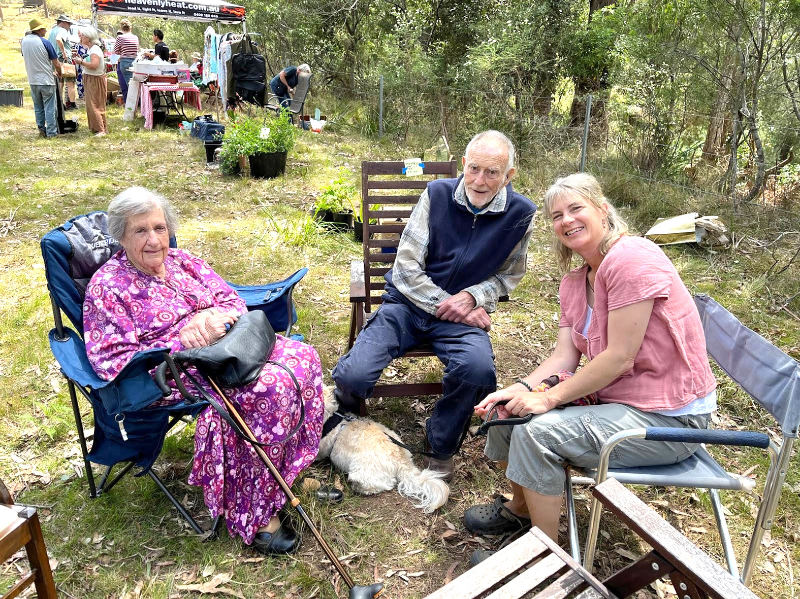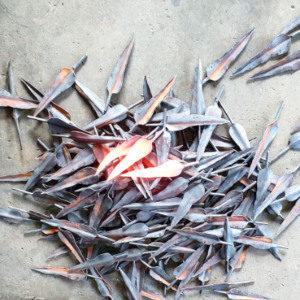Diggin Diggies
 My first opportunity to meet people in Diggies was a Christmas party chucked by Rob a few weeks after I moved here. Upon arrival, I caught eyes with Martin Kotvojs, who smiled at me perhaps sensing that I was a bit overwhelmed, or maybe because I was the only person he didn’t know. I wandered over and said, ‘Well, you look like the most interesting person here’ and he heartily agreed that indeed he was. He told me some stories that night of fleeing Vienna and Hitler in 1938, arriving in Australia in 1939 and buying a farm in Dignams Creek that he and his wife Dorothy had found soon after their marriage in 1961. He assured me that I was in the best place. He was right.
My first opportunity to meet people in Diggies was a Christmas party chucked by Rob a few weeks after I moved here. Upon arrival, I caught eyes with Martin Kotvojs, who smiled at me perhaps sensing that I was a bit overwhelmed, or maybe because I was the only person he didn’t know. I wandered over and said, ‘Well, you look like the most interesting person here’ and he heartily agreed that indeed he was. He told me some stories that night of fleeing Vienna and Hitler in 1938, arriving in Australia in 1939 and buying a farm in Dignams Creek that he and his wife Dorothy had found soon after their marriage in 1961. He assured me that I was in the best place. He was right.
Martin left us a few days ago. When Fiona told our community, there was an outpouring of loving support for her and fondness for this gentle man. Often noted was his cheeky sense of humour and storytelling on school runs in the old station wagon, stories that had Maggie in stitches while sitting in a fire truck with him waiting for orders. Mark recalled, ‘… his warm welcome, engaging stories and knowledge humbly shared … I soon discovered that everyone knew Martin. Wherever I went, people knew him and respected him – Martin was a legend. His stories seemed larger than life, but you soon realised that Martin lived life large – that was just normal life for him.’
In Tall But True: the story of my life, Martin shared the following wonderful words: ‘My advice is: keep your love of each other, of those around you and of life, live life to the full, keep your sense of fun and the ridiculous, take an interest in everything, nurture your hatred of dishonesty, sham and cruelty, your indignation at injustice, your rage at an outrage; and do whatever you can, however insignificant, to make this world a better place for your having passed through it.’ What excellent advice. Vale, dear Martin.
When Freda and Trent arrived at Diggies to housesit for William and Leigh, they said they were young, energetic and keen to be put to work. Their time here speaks volumes about the value of house-sitting as a way to address the housing crisis, but also to enrich communities. Not only have they created a huge new wonderland at Leigh and William’s place, but Freda has helped enormously in my and Didi’s gardens, worked with Heather in the nursery, looked after Sally Anne and Ged’s place, and athletically joined several Landcare working bees.
Freda observed this about Diggies: ‘I have looked after places all down the coast and often you might have neighbours that communicate, but Diggies is special because it’s very rare for communities to gather and support each other like you do here. Being at the foot of Gulaga, the richness of the earth, the diversity of species, everything is thriving. This is how everything should be! When people have ideas to keep rehabilitating the land, it would be silly to not help out.’ We will all be sad to see them go but hope they keep a little bit of Diggies magic and return soon.

Shannon Russack, Martin Kotvojs and Jenny van Stek at the Diggies Car Boot Sale November 2024. Photo: Kate Gooden
And a final word from Sally Anne, the Diggies Landcare kelpie who rounds us all up so well.
‘This month’s Landcare working bee was at Sol and Shanti’s place, home to a spectacular part of the creek with a few unwanted weeds to keep the group busy. Joining the party was the Local Land Services biosecurity expert, Chantelle. At the end of the session Chantelle gave key insights for tackling feral cats and deer as these two species have recently been sighted in Dignams Creek. Chantelle explained that feral cats and deer potentially pose the greatest threat to native fauna and flora. She stated that every feral cat on the loose kills approximately 700 native animals per year. According to Chantelle, feral cats kill more wildlife than foxes as foxes are scavengers and less effective hunters, hence cats do not respond well to bait. Apart from ringbarking trees, deer have ferocious appetites often devouring native seedlings leaving the future forest understorey devoid of much needed biodiversity.
Next steps for the Landcare group will be to look at effective ways of controlling these feral animals without causing any harm to native wildlife. The group plans to start by collecting data to determine how many feral cats and deer may be living in the area. Individuals will record sightings via the Feralscan app and further information will hopefully derive from placing thermal imaging cameras throughout the creek.’
Flick Ruby
Photo. (top): Freda hard at work in the hothouse. Photo: Flick Ruby

![Black and white image of people on the verandah of with the words Wagonga Ho[tel] on the roof.](https://thetriangle.org.au/wp-content/uploads/2025/10/Wagonga-300x300.jpg) /
/